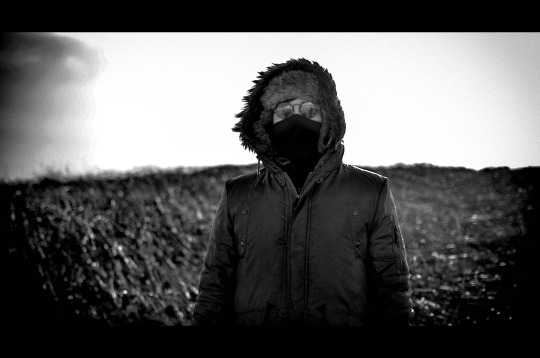Photo
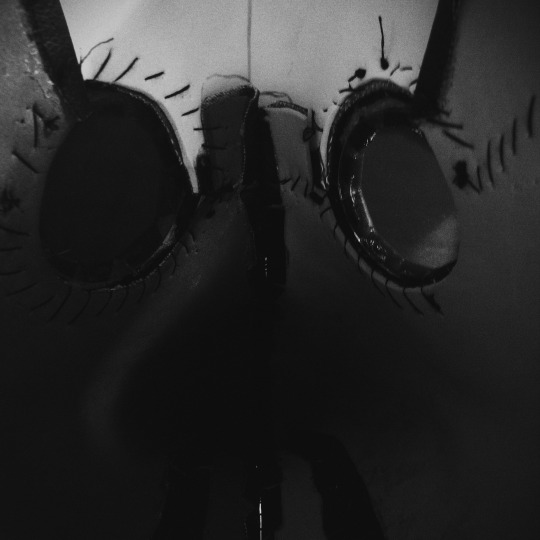
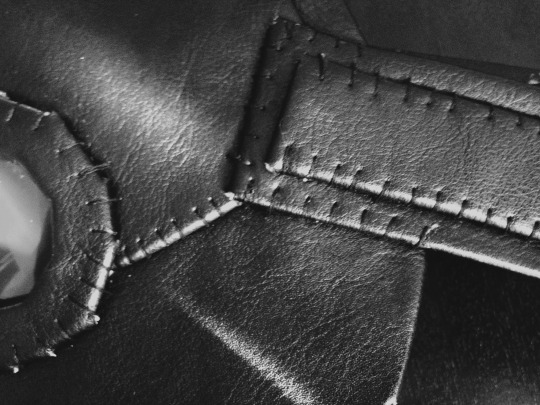
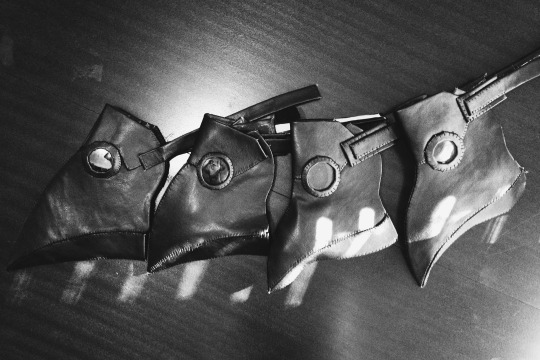
Mask FAQs
What type of masks are they?
The masks are commonly referred to as Plague doctor masks, which were worn by medical physicians during the european bubonic plague of the 14th century.
Where did you get the masks?
These masks are designed especially for L'Espai/La Espai
and every one of them were handcrafted with different sizes and shape to make each one unique and distinguishable.
How did you make the masks?
Lots of cutting, glueing and sewing.
What materials did you use?
Thin leatherette for the outer appearance which is glued and sewed on several shaped PVC foam for thickness. The eye lenses are acrylic plastic.
How long did take to finish one mask?
Between 8-10 hours straight with some tea breaks.
#Plague#Doctor#Mask#Plague_Doctor#Doctor_mask#Plague_Mask#handcrafted#Handcraft#Project#Leatherette#Art
0 notes
Text
- La Espai Evaluation (write up)
Name
‘La Espai’, Catalan for ‘the space’, was a title we came up with for the project to represent ideas of territory within a space (the performance area). For example, musical ideas competing against each other (discussed below), and identities projected which are closely linked with each other.
Initial Research
In September, Sean was exploring surround-sound panning using an iPad (http://goo.gl/7WmQMD), using the iPad app ‘Mira’, which connects with Max/MSP on a computer.
At the same time, Martin (http://goo.gl/znNSMk) performed an improvisational and experimental piece that takes on a sonata form, consisting of two electric guitars with effects pedals, which provided drone and melodic textural sounds, accompanied by a melodic electric piano.
Our second performance was when Martin and Sean worked as a pair (http://goo.gl/3gGblK) - this incorporated a pianist and guitarist.
Our third performance brought together both audio and visual ideas (http://goo.gl/cgdIs7). This could be seen as the beginning of La Espai as we know it; we now had four live musicians, with a couple of iPads.
Musically, we were improvising to two projections. While this was a valuable experience, it didn’t feel quite right. We felt that the improvisation was contrived (ironically); we were ‘mickey-mousing’ the visuals, which had too much of a narrative - we did not want this. Instead, we developed an idea that is more organic, where we allow the audience to perceive their own narrative.
Evaluations of all of the above performances are on this tumblr site.
January onwards
We’d decided that we wanted to progress with a surround-sound, four-screen, interactive media performance. However we had different visions for the project. Martin, the visual artist, wanted to design a surreal experience; Sean envisaged a noisy and gritty experience, designed to unsettle the audience. While in direct opposition with each other, we found a compromise that worked for both of us. Visually we would create something surreal and whilst musically Sean would use whole-tone scales to create floaty/dreamy textures, which then, through processing, would develop into thick, intense soundscapes (towards the end of the piece).
Key influences
Music/Software (Sean)
My interest in software development came into its own when I attended both NoiseFloor festival (2013 - Staffordshire University) and InTime music festival (2013 - Coventry University). During the former I witnessed lots of practitioners use a 16-speaker set up to pan their music, and the latter lots of people use Max/MSP and iPads to generate music.
While this was where my interest in music technology for performance originated, here are some more detailed examples that heavily influenced me:
An Ableton Live performance by Ben Bengler that I saw at NoiseFloor festival (https://vimeo.com/39285569 - this is elsewhere). The way in which rich harmonies were created from processing a small original sample was inspiring. The use of heavy audio processing in La Espai (present from 4:20 onwards, most clear from 9:00 onwards) was inspired by this.
‘Everything In Its Right Place’ by Radiohead (http://goo.gl/6f0YEg). The heavy use one of loop being central to the entire piece inspired me in composing a one-note loop on G# for the piano to loop for 10 minutes.
Similarly, whilst stylistically very different, Debussy’s ‘Voiles’ (http://goo.gl/Be8b6N) uses a Bb anchor to harmonically ground the piece, despite it using a whole-tone scale. The music of La Espai used such a scale, with an anchor note, which gradually changed. The electric guitar in La Espai created a drone of four notes at any one time, in this order:
Drone 1: F# F# F# F#
2: E F# F# F#
3: E E F# F#
4: D E F# F#
5: D D F# F#
6: D D E F#
7: D D E E
8: D D D E
9: D D D D
This was to gradually shift the harmonic grounding of La Espai from an F# to a D over 10 minutes. As the whole-tone scale does not have any root note, this was necessary; without this it would have sounded too ambiguous tonally.
Visuals (Martin)
I felt that this production needed a symbol or a strong “identity” for the audience to face, recognize and remember. At the time I was influenced by the lighting, setting and costume design of the 2013 film ‘A Field in England’. For example, the film displays subtle imagery of individuals standing isolated in an open outdoor space, with a dark vibe being given off.
Developing from this, I designed and created our own “Plague Doctor Masks”, which we wore and acted ourselves in the film. The masks have connections to space, territory and environment - to the Black Death and Bubonic Plague of the 14th century (a time and event of which the Plague Doctors originated from). I felt that, since this production and performance is heavily based on the ideas of territory and environment, the Plague Doctor mask was perfect as an identity.
Final Outcome
Here’s the setup/composition, as shown here http://goo.gl/PYj1kW:
A guitarist (Martin) and a pianist (Sam Mann) in a different corner of the room. Their respective audio output was played through a monitor. Martin played the sustained drones discussed above, and Sam set the pulse of the piece with the two-note loop in 5/4, before gradually adding to the loop. They each had an iPad for audio processing using Max/MSP (e.g. looping, long reverb, filters, delays).
The audio coming out of each monitor was gradually switched about halfway through the piece (through the Max/MSP patch); the pianist’s monitor now played guitar loops, and the guitarist’s monitor now played piano loops.
A drummer (Jim Mann) in another corner of the room, mic’ed up into a mixing desk, out into a monitor. Jim was in 4/4 throughout most of the piece, to phase in/out with Sam’s 5/4.
A violinist (Sean) in another corner of the room, mic’ed up into a mixing desk, out into a monitor. Sean was mostly in 3/4, to continue with this phasing (5/4 against 4/4 against 3/4).
Next to each performer was a screen, with a point-of-view, medium-shot projection of a character in a plague mask. It had natural lighting which aimed to make it realistic, with a chiaroscuro feel that felt very dramatic at the same time. The filming location was the aforementioned mountains, which gave it that sense of space we were aiming for.
Thoughts
+
It was the tightest performance yet, the textural processing sounded interesting (it’s different each time; naturally some instances sound better than others), and there was a good range in texture and dynamics throughout the piece (which is in A, B, C, B1 form - the B’s being more textural moments).
The audience were surrounded by the screens, which made it like they were part of that space and that they're in the middle of it all. Each character on the screens had their own character, which gave it a sense of personality and individualism.
From a theoretical perspective, the piece was about exploring concepts, ideas and relationships. By those standards, we feel that the work was very successful.
-
The guitar levels were a little quiet in the mix, the violin intonation was a little bit off at times, and technical limitations meant that we could not use an iOS device for each instrument to manipulate their sound (we did try this).
Visually, it would have been better to use four of the same projector to get the same image quality. Moreover, some of the film footage themselves weren’t consistent in terms of lighting (hard to control since the natural lighting of daylight was unpredictable). Finally, the pipes which Martin used to create the projection screens were unstable - in future they would need to be secured or if with more budget, to invest on actual quality rear-projector screens.
Grad Show Roles
Sean was assigned to the AV team, which was a case of liaising with the artists prior to the event to see what kind of setup they would require, collecting all of their media to import onto the host computer, and sitting at the lighting desk with other members of the team. Sean also was playing the violin for Sam and Jim Mann’s project, ‘Barbed Wire Trees’.
Martin was assigned to the documentary team, which involved taking pictures of peoples practices prior to the event, operating the live-cam feed on the day, recording videos on the day, taking some stills on the day, and helping with the AV team also.
Since we (along with Jim and Sam) were performing very different projects to the rest of the course, we were almost entirely self-reliant for the weekly practices in the dance studio, in terms of setup, stage management, AV, sound, and documentary.
1 note
·
View note
Video
youtube
- FINAL PERFORMANCE VIDEO -
0 notes
Video
youtube
Inspiration - Debussy - Voiles
Apart from one pentatonic passage and the odd chromaticism, the piece is made up entirely of whole tone scales, which an Bb anchor-note in the bass line, to give it a sense of harmonic grounding.
Similar ideas can be found in La Espai, where a repeated G# is present throughout much of the piece. Alongside this, the electric guitar part shifts the harmonic relationship between the parts by going through a series of drones, using just three notes: F#, E and D.
0 notes
Photo
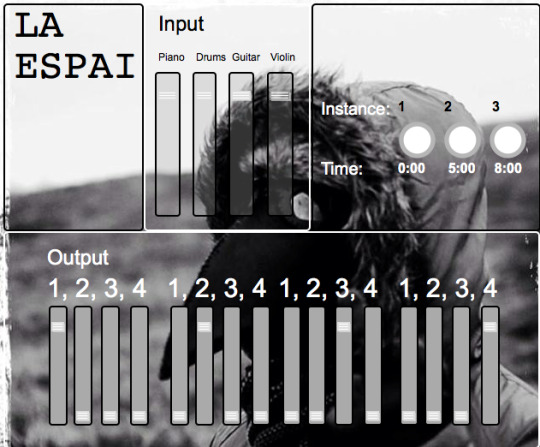
- 3D Sound Max/MSP Patch -
Here's the max patch Sean created to handle the panning mentioned in the previous post. In the centre at the top there's the input levels for each instrument, which can be adjusted in the sound check prior to each performance. From then on, everything is almost completely automated for the user of the max patch. They push the 'instance one' button at the beginning of the piece to set the output levels at a neutral position, and then 'instance two' (at approx 5 mins) to begin mixing two different signals together, and then 'instance three' (at approx 8 mins) to gradually take out the original signal out of the respective output.
In itself, the patch is just a way for the audio to be automatically panned with the push of a button, but its contribution to the piece is significant in that it adds to the surreal vibe we're going for.
Sean tested the patch today with a load of speakers and some midi samples, and it works really well. There were a couple of minor issues, such as identical monitors somehow outputting quieter signal than others, and getting the mix levels right. Solving the former is just a case of testing each monitor in sound checks, and the latter is being tweaked in the coming days.
*edit* Sean didn't use this version of the patch in the final performance. Due to technical problems with using live instruments instead of midi samples, the Max/MSP 3D sound was limited to the guitar and piano.
0 notes
Photo


- 3D sound explanation -
We've decided we're definitely going ahead with the process of 'rotating' the sound mid-performance, which will result in a mismatch between what the audience see and what they hear. Here's a diagram (it's very simple, but it illustrates the idea).
Instance one is from the beginning of the piece to approximately 5 minutes. Instance two occurs at around 5 minutes, and is a gradual shift which will take a couple of minutes in itself. By this point, when an audience member focuses their attention to one particular instrument, they'll hear something completely different.
Edit Due to technical limitations, the 3D sound was limited to the piano and guitar. This means that a few minutes into the piece, the sounds in their speaker will switch with eachother (the violin and drums will remain as is)
1 note
·
View note
Text
Schedule
Audio
Music composed and mapped out over Christmas
In January start practicing this, tweaking bits, group critique of music, bring all parts together, exploring the app.
By February, music semi-finalised and production of graphic scores.
By March, all music composed & graphic scores completed. Now just to practice and practice!
Visuals
New concept designs late-December to early-January
Projection Screens/Body frame building or assembling by Early to mid-January
Filming starts late January and finalised early-February
By March, all visuals prepared and ready for non-stop rehearsals.
Tech
All four iOS devices up and running by mid-January
In January, as part of group critique, we’ll gather feedback on app functionality
By mid-february, apps will be fully functioning and won’t need any more attention - so we can focus on the audio and the visual.
Documentation
Monthly detailed Vlogs with commentary starting January explaining the development process.
#La Espai#Music#Visuals#Experimental#University of South Wales#Creative Sound and Music#iOS#Projection#Plan
0 notes
Text
Audience/Market
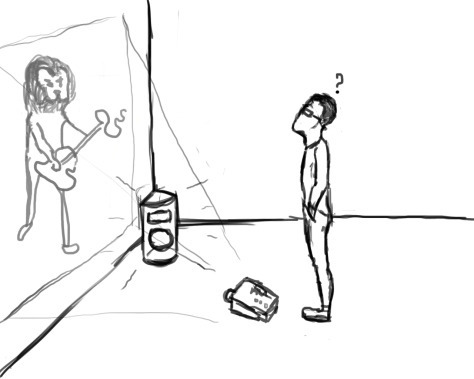
La Espai is fundamentally a quadraphonic/quad-screen audiovisual performance. However, it can also be seen as an installation of sorts, as the relationship it has with the audience isn’t conventional in a performative context.
While we are creating it as a live piece for four instruments and four iOS devices, for the sake of portability and convenience it could be worked into a fixed media system (more on this in the future development).
In terms of stylistic placement, La Espai would come under the broad term of ‘experimental’. For these reasons, the project could exist within a number of areas, including, but not limited to: traditional performance spaces, galleries, experimental music festivals (with indoor spaces). While this project is in no terms something designed for mass appeal, the potential audience it could attract is quite large, due to its incorporation of lots of ideas. For example, the audience could be one interested in the experimental arts, audio/visual work, music installations, the use of technology in music, multi-screen projections, software development, sound diffusion, and, of course, just incredible music!
Short term/local venue ideas
Noisefloor Festival (Staffordshire University). A range of music, including some AV works (and a 12 speaker diffusional system). www.benramsay.co.uk/noisefloor/
Chapter Arts Centre (Cardiff). Cultural centre for visual and performing arts with cinemas, gallery and performance spaces. http://www.chapter.org
Riverfront Theatre (Newport). The heart of the arts and entertainment scene in Newport [...] live performance programme[s], free visual art exhibitions http://goo.gl/Ss1dRO
Long term venue ideas
iFIMPaC (Leeds University). International Festival of Innovations in Music Production and Composition, which includes acousmatic, AV, acoustic with live electronics. http://goo.gl/0H9Cgi
CTM Festival (Berlin). Festival for 'adventurous' music and art. http://www.ctm-festival.de/news/
FIMAV (Victoriaville) Festival International de Musique actuelle de Victoriaville, hosting visual art, sound installations, contemporary music, jazz, rock, electroacoustic and improvisation. http://fimav.qc.ca
#University of South Wales#Creative Sound and Music#La Espai#Max/MSP#Projections#quadraphonic#quad-screen#market#audience#chapter arts centre#riverfront theatre#noisefloor festival#iFIMPaC#CTM festival#FIMAV#iOS
0 notes
Video
youtube
0 notes
Video
vimeo
0 notes
Video
youtube
+
Now four instrumentalists (percussionist hidden from view)
Therefore a much richer sound
Each speaker was assigned a particular role in the sound
First time both audio and visuals were combined
Graphic score worked well as a concept
Split screen narrative worked well as a concept
-
The four iOS controllers didn't work simultaneously, we we used two instead (the two that did work, worked well however!)
We were 'mickey mousing' the visuals - made the link too obvious
At this stage it was an online visual source instead of original material
Harmonically it was quite static
Texturally each player was competing to be most heard
#University of South Wales#Creative Sound and Music#La Espai#A/V#MaxMSP#Quadraphonic#Quadrivium#quad-screen#drone#loop#guitar#violin#piano#percussion
0 notes
Text
New Inspirations
Stanley Donwood
Misc.
https://www.youtube.com/watch?v=L2FoZC0jXts
0 notes
Photo

http://heymartin.wordpress.com/2013/11/28/live-development-2-rear-projection-d02/
0 notes
Video
+
Tech mostly worked
Individual control of loop levels
Some nicer effects, e.g. reverb and quality reducer
Use of live instruments now (no MIDI!)
The audience really enjoyed the guitar's noise generation
-
Too harmonically safe
Feedback levels went out of control at times - unable to record the live instruments
Max/MSP patch produced sudden loud moments
Live piano indistinguishable in the mix
Looping ability for the piano did drop out in the middle of the performance
0 notes

